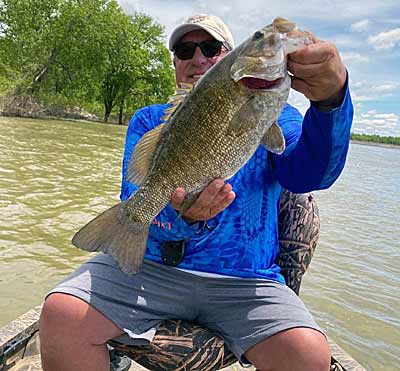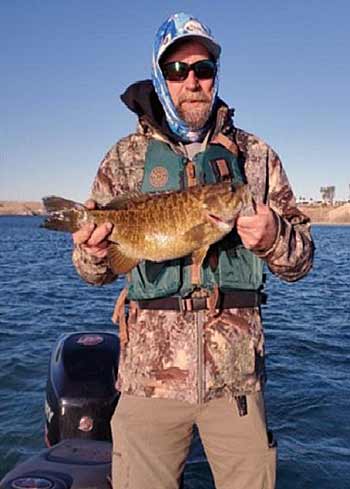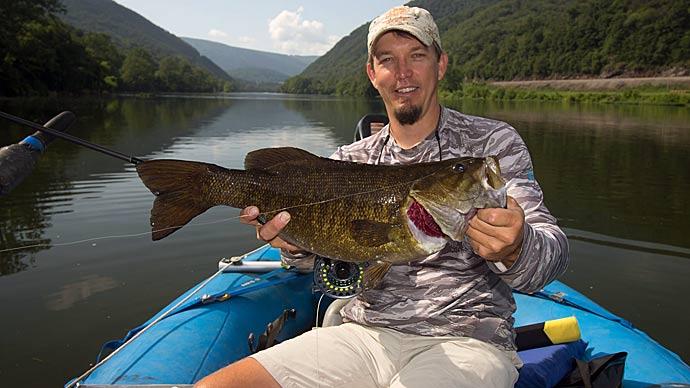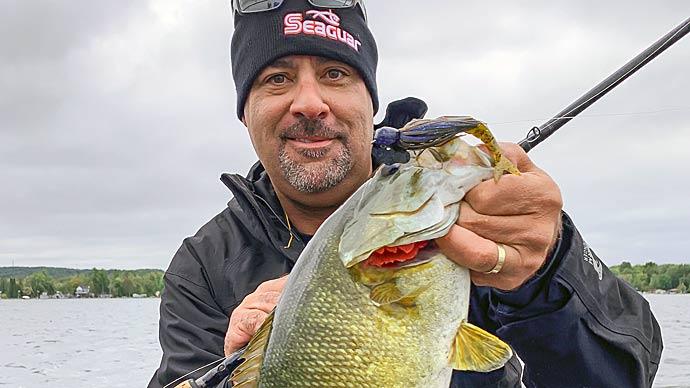
Inches, pounds, ounces — those details are rattled off by anglers when asked about their biggest bass. But most have committed many more to memory, even if their lunker of a lifetime slips away before it’s landed. Those heartbreaks always are remembered vividly.
Putting yourself in a position to catch your biggest smallmouth, regardless of what it weighs or measures, requires different details. While the where is essential, understanding how, when, and with what is paramount. Get those sorted, and you’ll be on your way to meeting that goal wherever you choose to fish.
Some waters produce big smallmouth, and fishing trips up your odds of catching your biggest one. These three guides regularly fish those places, putting clients on many big smallies, including the biggest of their life. Join them, and they’ll help you do the same. But if you can’t, putting their approaches, tips, and tricks to work on waters closer to home can have the same result.
Pick your time
Lake Ontario and the St. Lawrence River are constants on lists of big-smallmouth destinations, thanks lately to Bassmaster Elite Series tournaments. But they’ve seen their fair share of changes over decades. Zebra mussels, for example, turned the water gin clear, and gobies fueled dramatic growth rates in their smallmouths. “They are just part of the deal now,” said Bill Lortz, who has run NY North Country Bassin’ Guide Service on both waters for the past eight years. Other than downsizing the pound test of his fluorocarbon line, water clarity isn’t an issue but an attraction. He said seeing a smallmouth hooked 20 feet down is an exciting experience. And no one is complaining about their increased size.
There’s a narrow window for chasing these behemoths. While most of New York operates under two bass seasons — an open season from the third Saturday in June through Nov. 30 with the balance of the year being catch and immediate release fishing — the counties that include Lake Ontario’s northeast corner and the length of the St. Lawrence River only participate in the open season. These waters are shared with Ontario, Canada, which has a catch and release season through May 10, then an open season that starts with New York and lasts a few weeks longer.
Lortz said smallmouth are biting at the open season’s start when opportunities to catch prespawn stragglers and sight fish for late spawners remain. But his favorite time comes later when smallmouth swim into the mid-depths — 15 to 20 feet — to feed up for winter from late September through October. “They know the ice is coming; the cold water is coming,” he said. “The month of October can be magic up here.”
Wind dictates where Lortz fishes daily on this corner of the Great Lakes. But even when it’s blowing its hardest, there are sheltered places where you can fish in relative comfort. There are the cozy confines of “The Larry,” and behind Lake Ontario’s big islands, including Grenadier, Fox, Galloo, and Stony, massive Chaumont and Black River bays, and Henderson Harbor. Each has a population of giant smallmouth, which rarely intermingle.
Lortz prefers the lake. “I think there are bigger bass in the lake,” he said. “Lake fish don’t have to work as hard to live. The fish in the river have to fight that current all their life. It’s like living on a treadmill.” And there are more options, especially if you prefer fishing in shallow water. He said Chaumont, for example, is a relatively shallow fishery despite its size.

Lortz rotates through lures that fish best near or on the bottom, including grubs, tube jigs, and blade baits, such as a Silver Buddy, when the water is its coldest. He uses a drop shot, too, though its popularity often pushes him toward other lures, which smallmouth see less frequently. He lets the smallmouth decide which one is best on any given day.
While each location has its smallmouth, they all seek the same situation. “It’s all about the boulders,” Lortz said. “And you want cobble. You’re looking for a bottom that has both.” Smaller rocks shelter baitfish, he said, and boulders shelter smallmouth.
These spots are popular with other fish species, including the lake’s submarine-like walleye. Lortz said it’s not uncommon to catch them while fishing for smallmouth. You’ll catch bass of many sizes, too. But the opportunity for your biggest always lurks. “You can drop down and catch a 12-incher,” he said. “Then you’ll catch a 10-incher on your next drop. But that next one, that one could be a 6-pounder.”
Pick your spot
Big smallmouth aren’t limited to the North. Plenty swim in the South, too. Donald Hedge has chased them around Pickwick Lake — a Tennessee River impoundment that stretches across Alabama, Mississippi, and Tennessee — for almost 30 years. “It’s ideal for smallmouth,” he said. It produced Mississippi’s largest on record — 7 pounds, 15 ounces. And Alabama’s record — 10 pounds, 8 ounces — was caught from its upper end in 1950.
Hedge doesn’t look for smallmouth everywhere on Lake Pickwick, where he operates his namesake guide service. Its more than 43,000 acres makes that a haphazard approach. Instead, he focuses on its tailwaters below Wilson Dam at the extreme upstream end or below the Pickwick Dam. Both are hydroelectric projects, releasing water to generate power at certain times. That extra water flips the feeding switch for smallmouth. He said it’s possible to catch upwards of 40 in a day and have a shot at a 6-pounder. He has landed six 7-pounders over the last three years, and he’s heard of 8-pounders being caught.
Anglers travel from around the country to fish Pickwick. Hedge said about a third of his clients have caught their biggest smallmouth with him. While the fishery produces smallmouth year-round, he said fishing is tough when water isn’t being released. The increased current encourages smallmouth to feed and puts them in predictable spots such as behind boulders and along current seams. With a release schedule available three days in advance, he plans his fishing trips accordingly.
Getting to these smallmouth isn’t easy — at least at first. Hedge recommends having a guide or other Pickwick veteran show you how to navigate and read the water. “It isn’t hard once you’ve seen it done,” he said.
Hedge said catching them starts with securing bait — 4- to 8-inch skipjack herring — caught on small flies. The herring are fragile, so they are held in an aerated tank. He fishes them on a Carolina rig with a 30-pound test braided line as the main line and an 8-pound fluorocarbon or monofilament leader that measures 10 inches. Attached is a light-wire hook, gold in color and designed for crappie fishing. His rig’s weight depends on his goal. He uses a 1/16-ounce one when he wants his herring to drift through holes he believes smallmouth are holding. He jumps to a 1/2-ounce weight when he wants to fish it in a specific spot, tight-lining it in the current.
These tailwater sections aren’t deep, anywhere from 2 to 12 feet. And the smallmouth that live there will eat lures — crankbaits and swimbaits — fished in the same spots.
Pick your lures
Big largemouth usually dominate discussions about bass fishing in the Southwest. And while they are included when talk comes around Lake Havasu, its giant smallmouth monopolize the conversation. “I’ve been fishing Lake Havasu on and off for the last 30 years,” said Cory Hoopes, who operates Cap’n Corey Fishing Guide & Outfitters. “[The smallmouth fishing has] got nothing but better.”

A Colorado River impoundment that California and Arizona share, Havasu is known for big fish. The previous and current world record redear sunfish were caught here — 5.5 pounds and 5.8 pounds, respectively. And it produced Arizona’s record smallmouth — 6.3 pounds — in 2017.
The opportunity to catch one of Havasu’s giant smallmouth is always available. “They’re here year-round,” Hoopes said. But heat and pleasure boat traffic make catching one in summer a tall task, so he prefers targeting prespawn smallmouth, which are available from February through April. “My biggest smallmouth has come in February,” he said.
Smallmouth weigh the most during prespawn. That’s a good thing if you’re hunting your personal best. They also are hungry, packing in as many calories as possible for the rigors of the spawn. On a good day, Hoopes can catch 10 to 15 of them. “There are days when I catch 30,” he said. Those types of numbers can be reached on a spot or two. “But if I’m searching for big fish, I’m going to cover some water,” he said.
Hoopes looks for specific spots — windblown banks and points — and fishes them aggressively and quickly with a jerkbait. His favorite is a Megabass Vision 110 in a translucent baitfish pattern. It caught his biggest smallmouth, a 5.5-pounder. “When the jerkbait bite is on, there’s nothing better,” he said.
When the wind calms, and the water warms, Hoopes puts down his jerkbait and picks up a jig, usually a 1/2-ounce model built by TRT Custom Baits that features an Arkie-style head and a green pumpkin, brown and black, or black and blue skirt. He adds a matching trailer, the HMB (Hold My Beer!) that he designed, and TRT pours. He fishes it across structure and bottom transitions, where sand changes to gravel and rock in 2 to 20 feet of water. He also throws it around the almost 1,000 manmade fish structures planted in the lake.
Fishing the best lure on the best spots won’t guarantee a big smallmouth. Hoopes said Havasu’s smallmouth receive plenty of fishing pressure and are well aware of their surroundings, thanks to crystal clear water. “They are pretty smart,” he said. He compensates by holding his boat away from spots and making long casts. And his clothes are always natural colors. “Do anything you can to keep from spooking them,” he said.
But probably the essential part of chasing down your personal best smallmouth is persistence. “If you are going after a big bass, you have to have the patience to go after it and be let down a bit because you’re going after quality, not quantity,” Hoopes said.




